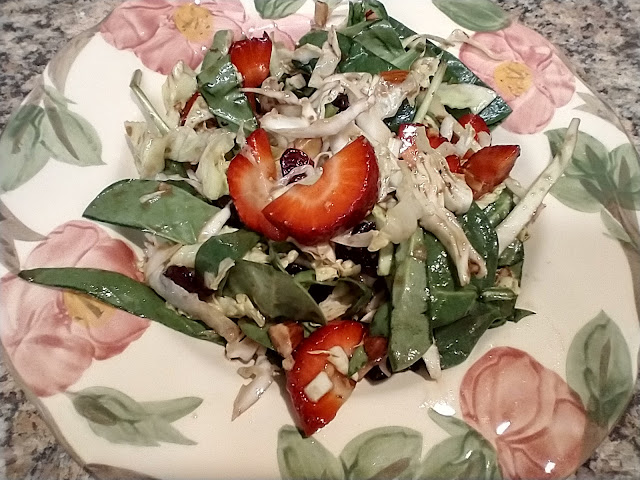
Recipe: Strawberry slaw with fig balsamic vinaigrette
 |
| Strawberries brighten this slaw. (Photo: Debbie Arrington) |
Early spring salads depend on something other than tomatoes to give them a burst of juicy flavor as contrast to crunchy greens.
Strawberries show off their savory side in this easy slaw with a touch of sweetness. Their bright color and tart taste work well with cabbage and spinach.
Although basic grape-based balsamic vinegar works in the vinaigrette, try fig or other fruit-based balsamic vinegar. It adds another note of sweet-tart flavor to accent the fresh strawberries.
Strawberry slaw with fig balsamic vinaigrette
Makes 2 servings
Ingredients:
8 strawberries, hulled and sliced
1 cup cabbage, thinly shredded
1 cup spinach, shredded or torn
¼ cup dried cranberries
¼ cup chopped almonds
For vinaigrette:
3 tablespoons extra virgin olive oil
1 tablespoon fig balsamic vinegar
1/2 teaspoon sugar
Salt and fresh ground pepper to taste
Instructions:
In a large bowl, place sliced strawberries, cabbage, spinach, dried cranberries and almonds.
Prepare vinaigrette. In a small jar with a tight-fitting lid (such as a half-pint mason jar), combine olive oil, balsamic vinegar, sugar, salt and pepper. Cover and shake until blended.
Pour vinaigrette over strawberry-cabbage mix. Toss lightly.
Serve immediately.
Comments
0 comments have been posted.Sacramento Digs Gardening to your inbox.
Sites We Like
Garden Checklist for week of July 21
Your garden needs you!
* Keep your vegetable garden watered, mulched and weeded. Water before 8 a.m. to reduce the chance of fungal infection and to conserve moisture.
* Feed vegetable plants bone meal, rock phosphate or other fertilizers high in phosphate to stimulate more blooms and fruiting. (But wait until daily high temperatures drop out of the 100s.)
* Don’t let tomatoes wilt or dry out completely. Give tomatoes a deep watering two to three times a week.
* Harvest vegetables promptly to encourage plants to produce more. Squash especially tends to grow rapidly in hot weather. Keep an eye on zucchini.
* Pinch back chrysanthemums for bushy plants and more flowers in September.
* Remove spent flowers from roses, daylilies and other bloomers as they finish flowering.
* Pinch off blooms from basil so the plant will grow more leaves.
* Cut back lavender after flowering to promote a second bloom.
* It's not too late to add a splash of color. Plant petunias, snapdragons, zinnias and marigolds.
* From seed, plant corn, pumpkins, radishes, winter squash and sunflowers.